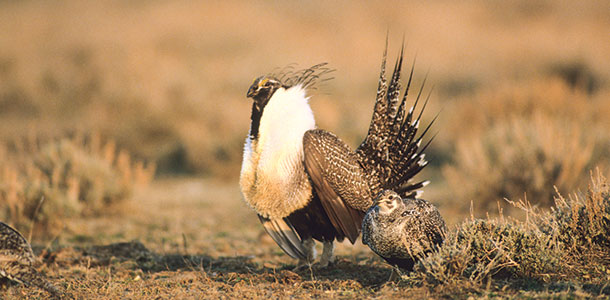Through conservation science and partnerships at the federal, state and local levels, we’re making a huge impact for conservation and agriculture.
We launched SGI in 2010 to target efforts to protect sage grouse and its habitat and to help sustain working rangelands for the long term. Through SGI, we’re bringing back grouse populations while at the same time helping to improve ranching operations.
Using farm bill conservation programs, we’re addressing non-regulatory threats facing the grouse, mainly fragmentation of their habitat, which is the primary reason for the grouse’s candidate designation under the Endangered Species Act.
Through SGI, we’re applying the right conservation practices in the right places to maximize our return on investment.
NRCS is not a regulatory agency, but we’re making a difference because private landowners voluntarily work with us to produce results on the ground. The decisions Western ranchers and other private landowners make every day about what to do on their land will continue to have a critical impact on the grouse.
The results speak for themselves. Today, 1,129 ranches across 11 Western states are conserving 4.4 million acres of land. That’s an area equivalent to two Yellowstone National Parks.
Since 2010, we have reduced habitat fragmentation by establishing more than 361,984 acres of conservation easements. Easements maintain large and intact working ranches and oftentimes also connect with other habitats on public lands.

Privately owned grazing lands underpin 40 percent of sage-grouse range and constitute some of the most productive habitats available. Through implementation of 2.4 million acres of grazing systems since 2010, SGI is helping ensure those lands are managed to provide optimum habitats long-term.
We’ve also greatly enhanced 405,241 acres of otherwise suitable habitat by removing invasive conifer. Focusing removal on early successional sites in priority habitats ensured maximum benefits to birds.
In addition to benefits for wildlife, we’re also preventing a loss of 60 percent of the available forage for livestock. Half our SGI conifer effort has been invested in Oregon, where we have now reduced more than 68 percent of the conifer threat on priority private lands.
Marking or removing more than 590 miles of high-risk fence is estimated to now prevent 2,600 sage-grouse fence collisions each year, reducing overall fence-strike risk by 83 percent.
SGI would not exist without the hard work and commitment from our partners – states, conservation districts, wildlife and agricultural groups, land trusts and federal partners. And our most important partner – the ranchers who are doing their part on their ranches to improve outcomes for sage grouse.
And our partners are excited about working with us to share the untold story of sage-grouse conservation. “The Nature Conservancy is proud to partner with NRCS and SGI on its science-based, targeted approach to sage-grouse conservation and habitat restoration,” said Len Barson, senior policy adviser at the Nature Conservancy.
“The results announced today are impressive, and we look forward to continuing to work together to protect sage grouse as an important part of our Western heritage.”
Over the past four years, NRCS has invested an unprecedented $296.5 million into SGI, and partners and landowners have provided an additional $128 million, bringing the total SGI investment to $424.5 million.
We’ve come a long way since 2010, and we have no intention of slowing down.
NRCS is committing $200 million to SGI over the life of the 2014 Farm Bill, providing partners with certainty that conservation will continue well into the future. This infusion will bring the total investment to approximately $750 million, enabling SGI to conserve an estimated 8 million acres by 2018.
SGI is living proof that wildlife and agriculture can coexist and thrive in harmony. You’ve heard it before: What’s good for the grouse is good for the rancher.
The steps we’re taking to improve habitats and outcomes for sage grouse and other wildlife are good for cattle, good for ranching operations and good for America’s rural economy. ![]()
Jason Weller is the chief of the USDA’s National Resource Conservation Service.
This originally appeared in the USDA blog.
PHOTOS
PHOTO 1: NRCS works with Utah rancher Jay Tanner to remove invading conifer trees on 9,000 acres. By doing so, he is enhancing the grasslands for his herd and sage grouse. Photo courtesy of Sage Grouse Initiative.
PHOTO 2: The greater sage grouse thrives in the sagebrush landscape of the West. Photo courtesy of USDA NRCS.





